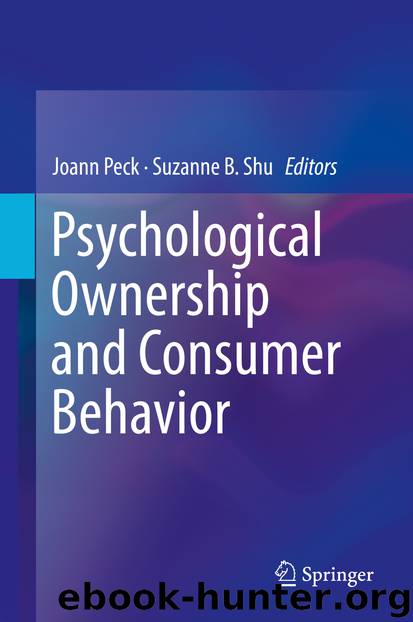Psychological Ownership and Consumer Behavior by Joann Peck & Suzanne B. Shu

Author:Joann Peck & Suzanne B. Shu
Language: eng
Format: epub
Publisher: Springer International Publishing, Cham
There are as many paths to developing and relinquishing possession as there are ways to interact with objects, so these eight paths are only intended to act as archetypes to inform decision making. Importantly, ownership is a mental state here, not a legal construct. Thus, ownership may begin at the first point of interaction, not at the point of sale. This understanding has many useful implications. For instance, if a product is sold as it climbs the path, it will likely be valued higher and offered at a higher price. If the product is seen as contaminated, it may be necessary to first cleanse the object in some way before selling it.
The area under each path might be thought of as the effort required by users to develop feelings of ownership towards objects. More effort is needed for Path A than for Path B and more still for Path D since it requires an ability to first scrub it of a previous user before taking ownership. Design can attempt to exploit the understanding emerging from these paths and the effort required. A notable example of this is seen with Path D. If engaging in an access-based model , for instance, many users report experiencing some kind of contaminated interaction. The entire interaction is short enough that they disengage with a negative experience. Design should seek to mitigate such contamination and consider the length of use that makes the most sense to gain meaning from the interaction.
Download
This site does not store any files on its server. We only index and link to content provided by other sites. Please contact the content providers to delete copyright contents if any and email us, we'll remove relevant links or contents immediately.
| Direct | Global |
| Industrial | Multilevel |
| Product Management | Research |
| Telemarketing | Web Marketing |
Influence: The Psychology of Persuasion by Robert B. Cialdini(4179)
The Miracle Morning by Hal Elrod(3910)
The Hacking of the American Mind by Robert H. Lustig(3580)
Pre-Suasion: A Revolutionary Way to Influence and Persuade by Robert Cialdini(3414)
Unlabel: Selling You Without Selling Out by Marc Ecko(2981)
Hidden Persuasion: 33 psychological influence techniques in advertising by Marc Andrews & Matthijs van Leeuwen & Rick van Baaren(2778)
Who Can You Trust? by Rachel Botsman(2732)
Kick Ass in College: Highest Rated "How to Study in College" Book | 77 Ninja Study Skills Tips and Career Strategies | Motivational for College Students: A Guerrilla Guide to College Success by Fox Gunnar(2720)
Purple Cow by Seth Godin(2698)
Ogilvy on Advertising by David Ogilvy(2682)
I Live in the Future & Here's How It Works by Nick Bilton(2524)
This Is Marketing by Seth Godin(2482)
The Marketing Plan Handbook: Develop Big-Picture Marketing Plans for Pennies on the Dollar by Robert W. Bly(2413)
The Power of Broke by Daymond John(2376)
Building a StoryBrand by Donald Miller(2360)
The 46 Rules of Genius: An Innovator's Guide to Creativity (Voices That Matter) by Marty Neumeier(2310)
Draw to Win: A Crash Course on How to Lead, Sell, and Innovate With Your Visual Mind by Dan Roam(2277)
The Tipping Point by Malcolm Gladwell(2204)
Market Wizards by Jack D. Schwager(2163)
